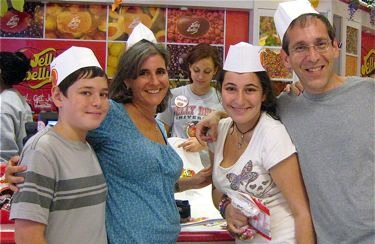In 2011, my family and I joined 1,000 other Jews, mostly young post-army Israeli backpackers, at the Yak and Yeti Hotel in Kathmandu for what’s described as the largest Pesach Seder in the world.
Run by the local Chabad, that Seder in Nepal was certainly the most unique we’d ever been to. But if we were hoping for an uplifting, even spiritual, experience, we would be sorely disappointed. Rabbi Chezki Lifshitz essentially speed-read the Haggadah as if it were a greatest hits album. We finished the entire story and were washing for matzah in under 50 minutes – including extended breaks to sing Ma Nishtana and Dayenu.
Nor was the food any better. No expense seemed spared to import hand-made shmurah matzah and, for some reason, gallons of coleslaw. But when it came to the meat, there were just seven small nuggets of chicken on a plate at the center of our table.
We were nine people.
The evening wasn’t an entire flop. My wife, Jody, won first prize in the pre-Seder raffle – a bungee jump off a 160-meter (525-foot) high suspension bridge. (She gave it to one of the young Israelis.)
Our Passover in Kathmandu has led to a new Seder tradition where I ask everyone assembled to recount their most memorable Pesach experience. This year I opened the question up to friends.
Here’s some of what they shared.
Debbie Zimelman was in Leningrad in 1988, “to convince Russian Jews to make aliyah.” Like our meal in Kathmandu, Debbie’s was minimalist, consisting of just “beets, potatoes and wine. For an added bonus, I drank the water – and got a parasite. No one told me it wasn’t OK to drink the water in Leningrad!”
Sara Hirschhorn had more food than Debbie, but it was augmented by a crunchy tradition from the Seder leader, a Jew from Gibraltar, who “literally shaved a bit of brick into the charoset,” presumably to accentuate the slave and mortar metaphor.
That might have been more appetizing compared to what Lynnsie Balk Kantor experienced at a Seder in Rome in 1982 when “instead of a little piece of bone for the shank bone on the Seder plate, they had a part of a leg of some animal – complete with fur!”
Debra Askanase found herself with food but no Haggadah while working in Nicaragua in 1997. “We were three Jews and four non-Jews at an Italian restaurant, trying to remember the words! We did the best we could and literally pointed to imaginary items on a large plate at times.”
Tal Berlinger was on an exchange program in Germany where she “tried making Seder and explaining it to the other students. After five minutes, the stories sounded so ridiculous, I just served them dinner and sang the songs for myself after they left.”
Rachel Yona Shalev may have had the closest experience to our family’s. In 1992, she was in a Himalayan village. “We created a Seder from what they had, including burning the chapatis to look and taste like matzah.”
Debbi Hirsch Levran shared that her most memorable Seder “was actually the one year I didn’t celebrate. I was an exchange student in France. For the first night of the holiday, our group was on a trip where we slept in a monastery. The evening’s activity was…baking bread!”
Several friends noted that their Seders alone during the Covid-19 lockdowns were their most “unique” Passovers.
“For my solo Seder, I decided to wear a beautiful embroidered green silk bathrobe,” Ruthi Soudack told me. “How often can you wear a bathrobe to a Seder? I was the best dressed host and the best dressed guest at my Seder!”
Seders are family time – even if that can sometimes conflict with Jewish Law. Leonie Lachmish relates how, at a Seder she attended in 1970, among the guests was a family who had just escaped from Lebanon.
“The father was a magnificent pianist,” Leonie explains. “He went straight to the piano after the Seder and played the most wonderful music. We weren’t about to tell a man who was celebrating the miracle and relief of his personal freedom that, according to halacha, he shouldn’t be playing the piano on a festival. We literally danced until someone said, ‘It’s time to say the Shema!’”
For profound Seder experiences in dark times, though, it’s hard to top that of Scott Lenga’s father, Harry, who, along with his two brothers, marked Pesach in the German slave labor camp in Wroclaw, Poland during World War II.
The Lenga brothers were watchmakers who had fixed the timepieces of some of their captors working in the kitchen. “I asked them to give us a little flour. We mixed it with water and put the dough on the top of our little iron stove to cook three kleine matalach (little matzas),” Lenga writes in the memoir compiled by his son, The Watchmakers: The Story of Brotherhood, Survival, and Hope Amid the Holocaust (to be published in June, preorder at scottlenga.com).
“We took turns reciting sections by heart, but quietly – in whispers,” Lenga continues. “If the Germans found out what we were doing, they would have killed us.”
When it came time for the second half of the Seder – when participants traditionally sing joyous songs of praise to God – the brothers cut their Seder short. “We weren’t happy enough. Instead, we asked God, ‘Why do you let this happen to us? We were angry at God. But we had made a Seder” – a declaration that for Lenga proclaimed, “We still exist, and we still can do a thing like that. But who knows for how long?”
Kind of puts into perspective those seven little chicken nuggets in Nepal.
I originally shared stories of exotic Seders around the world at The Jerusalem Post.


